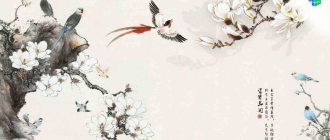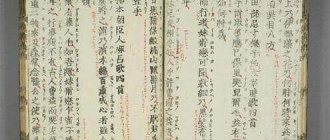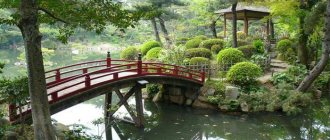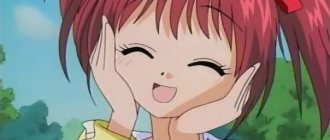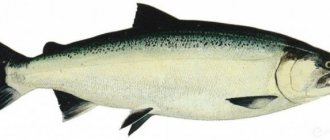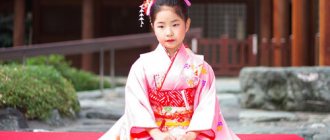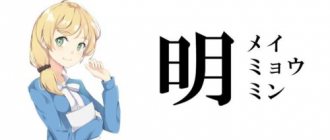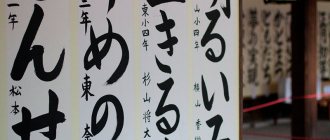What is haiku?
Haiku is a traditional Japanese poetic form consisting of three syllabic units, the first and third of which contain five syllables, and the second seven, making these Japanese poems a total of seventeen syllables. Otherwise, their structure can be written as 5-7-5. With syllabic versification, stress is not important, rhyme is also absent - only the number of syllables matters.
In the original, Japanese haiku are written in one line (one column of hieroglyphs). But in translation into Russian and other languages, usually European, it was customary to write down these Japanese verses in the form of three lines, each of which corresponds to a separate syllabic block, that is, the first line of the tercet consists of five syllables, the second - of seven, the third - out of five.
A small crab ran along my leg. Pure water. Matsuo Basho
In terms of semantic content, Japanese poems, using various means, depict natural phenomena and images that are inextricably linked with human life, emphasizing the unity of nature and man.
How is haiku different from haiku?
You might be confused by the fact that some Japanese poetry is also called haiku, but there is an explanation for this confusion.
Initially, the word “haiku” denoted the first stanza of renga, one of the many genres of ancient Japanese poetry. It could be called a poetic dialogue, or even a polylogue, since it was very often written by two or more poets. Literally, renga means “stringing of stanzas.”
The first stanza of the rengi is written with seventeen syllables in a 5-7-5 pattern - this is haiku. Then comes the second stanza of fourteen syllables - 7-7. The third and fourth stanzas, as well as all subsequent ones, repeat this pattern, that is, the renga scheme looks like 5-7-5-7-7-5-7-5-7-7-…5-7-5-7-7. The number of stanzas is not limited in principle.
If we separate the first and second stanzas from the renga (5-7-5-7-7), we get another popular poetic form in which Japanese poetry is still written - it consists of thirty-one syllables and is called tanka. In translations into European languages, tanka is written in the form of a pentaverse.
Later, haiku became an independent genre, as Japanese poets began to write these poems outside the framework of rengi. And in order to distinguish between independent Japanese tercets and the very first stanza of rengi, in the 21st century the Japanese poet Masaoka Shiki proposed using the term “haiku” for the former. This is exactly what the Japanese themselves now call such tercets.
From the history of haiku
This genre of Japanese poetry originated back in the 14th century within another genre, waka, which was widespread in Japan at that time, which can be translated as “Japanese song.” Waka, in turn, was divided into such types as short and long poetic messages (tanka - short, teka - long).
The new genre became a continuation and development, so to speak, of the “short song” and was originally called “haiku”. A huge contribution to the development of the genre was made by the Japanese poet and theorist Matsuo Basho (1644-1694, surname read as “Basyo”), who gave the poetic forms precision and elegance:
He literally blew up the world of Japanese poetry by writing in 1681 a tercist, unusual by the standards of the 17th century :
On a dead branch
The raven turns black...
Autumn evening…
As Professor Elena Dyakonova, candidate of philological sciences and specialist in Japanese literature, notes, this is only one of the options for how to translate this Basho haiku into Russian [E. Dyakonova, 2019]. This literary translation, proposed by the Russian poet and translator Konstantin Balmont, in any case, does not coincide with the literal one, because literally this Basho haiku translates as “A raven sits on a dry branch... Autumn twilight.” As you can see, it’s not impressive, but in the Japanese poetic tradition, it’s customary to not describe a lot of things, but to imply them so that readers can guess it themselves.
One way or another, the canons of haiku proposed by Matsuo Basho remained unshakable until the end of the 19th century. By the end of the 19th century, there was a need to update the genre and traditional poetry in general. On the wave of renewal that was raised in the poetry community by the Japanese poet and literary critic Masaoka Shiki (1867-1902), a new name for the genre “haiku” appeared, which he also proposed. The name “haiku” has stuck and is used to this day, and the poet who gave preference to this genre is called haijin:
What changes have befallen the genre, besides changing the name? Masaoka Shiki brought it closer to realism by introducing into poetry the literary method he developed, shasei, which can be translated as “sketches from life.” In haiku, it is more common to describe rather than imply, which has made the genre less mysterious, but more understandable to the mass reader, including Western ones. An example is the following Shiki tercet:
My front garden...
Bloomed here for the first time today
Peony flower...
Like Matsuo Basho, Shiki also loved to write about nature, but, as we can see, there is no intrigue. Which, however, does not detract from the beauty of the tercet. Since the beginning of the 20th century, updated Japanese haiku began to be actively translated into various European languages, thanks to which Japanese poetry became better known outside the country and turned haiku into poetry for the general public.
By the way, the three-line recording format appeared precisely after Japanese haiku poems began to be translated into European languages. In the traditional version, haiku is written in hieroglyphs in a column from top to bottom. Today in Japan, a modern version of writing horizontally in one line is also common.
In Western culture, attempts have also been made to borrow the Japanese tradition of writing haiku in one line. Thus, Hiroaki Sato, who translated haiku into English, considered it logical to write the translation in one line, like the original poems. The idea did not catch on, and Sato himself is better known not as a translator or literary theorist, but as the author of the work “Samurai. True stories and legends" [H. Sato, 2019].
The Canadian poet and theorist Clarence Matsuo-Allard went even further in his ideas, believing that the original haiku in English should be written in one line. This idea also turned out to be too radical for English-language authors and was not developed.
It is significant that in the Russian literary tradition haiku were always written in three lines, and there were no special attempts to change the established tradition. This is despite the fact that for a Russian person, monoshits without division into lines are quite familiar. Suffice it to recall the poet Vladimir Vishnevsky and his one-liner “I wish I could get dressed once and for all,”
“It’s becoming less and less common to say, “That’s great,” “There’s no time for slow dancing,” and others.
We will return to the topic of haiku later, but for now let’s talk about the literary features of the genre.
Japanese tercets: formal elements
As we have already found out, if you write the original Japanese haiku as tercets, then each line will represent one syllabic block of five, seven and five syllables, respectively. In Russian, it is not possible to strictly observe this rule, because the length of words here differs from the length of words in Japanese.
Therefore, it was decided that Russian poetry could differ in structure from the 5-7-5 scheme, but the length of each line should not exceed ten syllables, and one of the lines should be longer than all the others.
You smiled. From a slow ice floe in the distance, a Bird takes off. Andrey Shlyakhov
An important element is kigo - the so-called seasonal words. Their function is to indicate the season or period of time at which the action described in the poem takes place. Such a word either directly names a season of the year, for example, “summer morning,” or denotes an event associated with this season, from which the reader can immediately guess what period of time is depicted in the poem.
The Japanese language has its own kigo, indicating the natural and cultural attractions of Japan, and in our country such words can be, for example, “the first snowdrops” - this is spring, “the first bell” - autumn, the first of September, etc.
Even though there is no rain, On the day of planting bamboo - A raincoat and an umbrella. Matsuo Basho
The second component that characterizes Japanese poetry is kireji, or the so-called cutting word. There are simply no analogues to it in other languages, therefore, when translating poetry into Russian or when writing original Russian tercets, cutting words are replaced with punctuation marks, expressing them using intonation. In addition, all such Japanese tercets can be written with a lowercase letter.
Japanese poems are characterized by the concept of two-partism - dividing the poem into two parts, twelve and five syllables each. In haiku in Russian, you also need to observe two parts: do not write poems in three complete sentences, as well as do not write them in the form of one sentence. Both the first and second parts of the tercet should describe different things, but be interconnected in meaning.
Indian summer... children laugh at the street preacher. Vladislav Vasiliev
Cheat Sheet of Poetic Forms and Japanese Poetry
=========================== CHEET SHEET ====================== ===== In Japanese poetics there is a term “after-feeling”. The deep echo generated by the tanka does not subside immediately. A feeling, compressed like a spring, opens up, an image sketched in two or three strokes appears in its original integrity. The ability to awaken the imagination is one of the main properties of Japanese poetry in small forms. A short poem (just a few words) can become a powerful capacitor of thought and feeling. Each poem is a small poem. She calls you to think, to feel, to open your inner vision and inner hearing. Sensitive readers are co-creators of poetry. Tanka, literally “short song,” originated in the depths of folk melodies in ancient times. It is still recited in a chanting manner, following a certain melody. Thangka is just five verses. The metric system of the tank is extremely simple. Japanese poetry is syllabic. A syllable consists of a vowel sound or a consonant combined with a vowel; There are not very many such combinations. Frequent repetitions create a melodious euphony. Tanka contains many constant poetic epithets and stable metaphors. There is no final rhyme; it is more than replaced by the finest orchestration, a roll call of consonances at the beginning and in the middle of the verses. (from the preface by Vera Markova to the book “Japanese five-line. A drop of dew”) https://www.stihi.ru/diary/svetlanavalent/2015-07-12 Tanka (otherwise waka or uta) is a traditional genre of Japanese poetry, a syllabic five-line in size 5-7-5-7-7 syllables. *(In the competition, deviations from the canon of the form are allowed for a 5-syllable line - 4-6 syllables, for a 7-syllable line - 6-9 syllables. However, the form 5-7-5-7-7 is preferable.)
At my gate There are ripe fruits on the elm trees, Hundreds of birds are nibbling them, having flown in, Thousands of different birds have gathered, - But you, beloved, are not there... Unknown author (translation by A. Gluskina.)
“According to the classical canon, the tanka should consist of two stanzas. The first stanza contains three lines of 5-7-5 syllables, respectively, and the second - two lines of 7-7 syllables. The total is a five-line verse of 31 syllables. This is what form is all about. I draw your attention to the fact that a line and a stanza are different things. The content should be like this. The first stanza presents a natural image, the second - the feeling or sensation that this image evokes. Or vice versa." (Elena One of the most accurate definitions of yugen can be recognized as Tanka Fujiwara Toshinari, who created his teaching about yugen in poetry:
In the twilight of the evening, an autumn whirlwind over the fields pierces the soul... A quail's complaint! Village of Deep Grass.
Yugen is a feeling of the fragility of existing things, but poets loved the state of “wandering in uncertainty” (tadayou). If aware is light yang, then yugen is impenetrable yin...
TANKA 5-7-5-7-7 is a short song * has no rhyme * The first three lines of a tanka are haiku, or haiku * In general, the first three lines should be one sentence. * must consist of TWO stanzas (not formally divided by a space). - The first stanza represents a natural image, - the second - the feeling or sensation that this image evokes. * has styles: aware - light yang, yugen - impenetrable yin, intimate, secret, mystical tadayou - wandering in uncertainty" * ! past tense is not allowed in tanka *! There is a controversial issue regarding pronouns. (FUJIWARA SADAIE also uses them) “...Only I have not changed here, Like this old oak tree” (M. Basho) - Here you have both the pronoun and the past tense
+++ Deep in the mountains, a moaning deer tramples a red maple leaf
I hear him crying... all the autumn sadness is in me
HAIKU-Hoku 5—7—5
* haiku text is divided in a 12:5 ratio - either on the 5th syllable or on the 12th. * the central place is occupied by a natural image, explicitly or implicitly correlated with human life. * the text must indicate the season - for this purpose kigo - “seasonal word” is used as a mandatory element * haiku is written only in the present tense: the author writes down his immediate impressions of what he has just seen or heard. * haiku has no name * does not use rhyme * The art of writing a haiku is the ability to describe a moment in three lines. * every word, every image counts, they acquire special weight and significance * Saying a lot using only a few words is the main principle of haiku. * Haiku poems are often printed on a separate page. This is done so that the reader can thoughtfully, without rushing, penetrate the atmosphere of the poem. ++++ A raven sits alone on a bare branch. Autumn Evening (Matsuo Basho)
RUBAI - quatrains that rhyme like
* aaba, - the first, second and fourth rhyme...... less often - * aaaa, - all four lines rhyme.
++++ Flowers in one hand, a permanent glass in the other, Feast with your beloved, forgetting about the whole universe, Until a tornado of death suddenly tears off the petals from a rose, the shirt of mortal life. (Omar Khayyam)
I went out into the garden in sorrow and was not happy about the morning. The nightingale sang to Rose in a mysterious way: “Show yourself from the bud, rejoice in the morning, How many wonderful flowers this garden has given!” (Omar Khayyam)
SINQWINE 2—4—6—8—2
* used for didactic purposes, as an effective method for developing figurative speech * useful as a tool for synthesizing complex information, as a cross-section for assessing students’ conceptual and vocabulary knowledge. * Sinkwine 1 line - a noun denoting the theme of syncwine 2 line - 2 adjectives, revealing some interesting, characteristic features of the phenomenon of the object stated in the theme of syncwine 3 line - 3 verbs, revealing actions, influences characteristic of this phenomenon, the subject 4 line - phrase , revealing the essence of a phenomenon, an object, reinforcing the previous two lines; line 5 is a noun that acts as a result, conclusion
Reverse syncwine - with the reverse sequence of verses (2-8-6-4-2); Mirror syncwine is a form of two five-line stanzas, where the first is a traditional syncwine, and the second is a reverse syncwine;
Cinquain butterfly - 2-4-6-8-2-8-6-4-2; Crown of cinquains - 5 traditional cinquains forming a complete poem; A garland of cinquains is an analogue of a wreath of sonnets, *a crown of cinquains, to which is added a sixth cinquain, where the first line is taken from the first syncwine, the second line from the second, etc.
Strict adherence to the rules for writing syncwine is not necessary. For example, to improve the text, you can use three or five words in the fourth line, and two words in the fifth line. It is possible to use other parts of speech. Writing a syncwine is a form of free creativity that requires the author to be able to find the most significant elements in information material, draw conclusions and formulate them briefly. In addition to the use of syncwines in literature lessons (for example, to summarize a completed work), it is also practiced to use a syncwine as a final assignment on the material covered in any other discipline.
WEDSING - ultra-short poetic form
*poem of two lines with a total of six syllables. 3+3 or 2+4. * there should be no more than five words * there should be no punctuation marks.
++++ Japanese butterfly (Alexey Vernitsky)
Siberia hyperlink (Roman Savosta)
where we are good there (Oleg Yaroshev)
Continuation
https://www.stihi.ru/2015/07/09/8554 Self-study in writing Japanese poetry, part 1
Senryu (Japanese; “river willow”) is a genre of Japanese poetry that emerged during the Edo period. The form coincides with a haiku, that is, it is a tercet consisting of lines of 5, 7 and 5 syllables in length. But, unlike the lyrical genre of haiku, senryu is a satirical and humorous genre, far from admiring the beauty of nature. It is characteristic that senryu usually do not contain kigo - indications of one of the four seasons, mandatory for classical haiku.
In Japan's laughter culture, humor has always prevailed over satire. T. Grigorieva writes about this in the book “Japanese Artistic Tradition”. Therefore, haiku in the senryu genre were not persecuted by the authorities, as would happen with satirical works. Satire can end up in opposition to power even when it does not touch upon social issues: through the constant denunciation of morals, if the spiritual authorities consider this a violation of the monopoly of the top on criticism. But the senryu did not engage in moral denunciation of ordinary human vices. It is rather, even in satirical poems, a genre of joke, anecdote, sketch.
Although outwardly, in their content, senryu are similar to European jokes, there is a fundamental difference between senryu and the European laughter tradition. Senryu had a serious ideological justification, and senryu masters did not consider themselves poets inferior in aesthetics to the poets of past eras. Laughter in Japanese is "okashi". Here is what T. Grigorieva writes about the laughter culture of 18th-century Japan: “It is not surprising that Hisamatsu puts okashi on a par with aware, yugen, and sabi. They have equal rights. Each time has its own feeling: the severity of Nara, the beauty of Heian, the sadness of Muromachi, the laughter of Edo. Society removed what it was losing interest in and brought to the fore what it needed. The criterion of beauty remained constant.”
Senryu got their name from the poet Karai Senryu (;;;;, 1718-1790), thanks to whom the genre gained popularity.
Useful links https://haiku.ru/frog/def.htm Alexey Andreev WHAT IS HAIKU? https://www.haikupedia.ru/ Haikupedia - encyclopedia of haiku https://tkana.zhuka.ru/kama/ugan/ In the style of yugen https://www.stihi.ru/2015/07/06/4101 meetings at star bridge V. competition poems Haiku competition (judging rules) https://www.stihi.ru/avtor/rengekonkurs Ryoanji Garden Competitions https://www.stihi.ru/2015/07/03/140 goodbye forever... acro- tank... attempt 6 https://termitnik.dp.ua/poem/152528/ TERMITnik of poetry Classics (Acro-tank) Konstantin
https://www.stihi.ru/avtor/wanadis Tania Vanadis https://www.stihi.ru/avtor/cunamisan Tsunami San https://www.stihi.ru/2013/01/07/7485 Dictionary of Russian kigo - seasonal words
1. Haiku or haiku - (initial stanza) unrhymed tercets of 17 syllables (5+7+5). 2. Tanka - (short song) unrhymed five lines of 31 syllables (5+7+5+7+7). The roots of poetry are in the human heart. 3. Kyoka - (crazy poetry), size like a tanka. 4. Rakushu is a satirical type of tank. 5. Teka or Nagauta - (long song), tanka size, up to 100 lines. 6. Busoku-sekitai - (the soul of nature - the soul of man) translated - “Trace of the Buddha” - unrhymed six lines of 38 syllables (5+7+5+7+7+7). 7. Sedoka - (song of the rowers) unrhymed six lines of 38 syllables (5+7+7+5+7+7). 8. Shintaishi - (new verse) - the beginning, like a tanka, the total volume is unlimited - romantic poetry was approved by the poet Shimazaki Toson at the beginning of the twentieth century. 9. Cinquain - unrhymed five-line verse of 22 syllables (2+4+6+8+2) - was invented and put into use at the beginning of the twentieth century by the American poetess A. Crepsi.
SEDOKA - A genre of Japanese poetry - six lines in which the syllables in the lines are arranged as follows: 5-7-7-5-7-7
The eyes are sad, Wrinkles are like paths. Left behind by life... Where is the surgeon, What does plastic surgery of the Body and soul?... KLARA RUBIN, LITO MEMBER, ... We have been coexisting for a very long time. But they didn’t have time to talk. It would be nice in heaven for us to be in the same squadron. ALEXANDER FREIDLES, MEMBER OF LITO, ... It's drizzling rain. My pride is crying, Saying goodbye to you in my thoughts - Captive of feelings. The soul will perk up a little. Wash away the tears from your face. KIRA KRUZIS IS A MEMBER OF LITO.
PS: Do not use the cheat sheet as the basis for everything... it was collected from what was available on the Internet at that time (it was created for me)
© Copyright: My Sun, 2015
https://www.stihi.ru/2015/07/09/5249
Writing Japanese Poems Correctly: Basic Principles of Haiku
- Writing haiku is quite different from writing classical rhyming poetry. To write poetry in the Japanese style, you need to learn to use a minimum number of words, but filled with the necessary meaning, and cut off all that is unnecessary. It is important to avoid repetitions, tautologies and cognates, if possible. Being able to say a lot through a little is the main principle of writing Japanese tercets.
- Learn to convey meaning without describing it literally. The author has the right to understatement: his task is to evoke certain feelings and sensations in readers, and not to chew them in detail. Readers need to figure out and understand the author’s content on their own. But at the same time, this content should be easily understandable; the reader should not sit for hours and solve a single tercet.
First summer rain. I open and... fold the umbrella. Felix Tammy
- Japanese haiku do not tolerate pathos and artificiality. The art of composing tercets is based on sincerity, so do not compose something that cannot actually happen. Such Japanese poetry should be understandable to everyone, so do not use slang words and expressions when writing.
- Haiku should only be written in the present tense form, since these Japanese poems depict only those events that have just happened and were seen, heard or felt by the author.
- Japanese poetry is richer in homonyms than Russian, but when writing Russian tercets, you should not miss the opportunity to use wordplay.
The ferry leaves, the soul is torn in the wind... Goodbye and don't cry. O'Sanchez
- A technique that Japanese poets often use is a comparison of various phenomena and objects. The main condition is the use of comparisons that happen naturally and that do not need to be supported by comparative words and conjunctions “as if,” “like,” etc.
All the paths are covered with snow... the neighbor goes out into the yard with his own path. Taisha
We hope that our tips will help you master the art of composing haiku. And now we invite you to learn from the best and watch the following video, which examines Japanese poetry, in particular, such famous Japanese poets as Matsuo Basho, Kobayashi Issa, Yesa Buson and many others.
How did haiku come about?
To understand what haiku is and why it’s great, you should look at the history of the genre. The name literally means “initial stanza,” which shows its historical affiliation with renga, an ancient form of versification in Japan. The independent life of the genre of poetry began in the 17th century, when Edo was the capital. In the 19th century, the haiku genre appeared, incorporating some of the poems previously called haiku.
For the Japanese, haiku is not just poetry, but also a reflection of the worldview, the idea of beauty, and the philosophy of life. A small work (only three lines!) is filled with deep meaning.
It is known that haiku has roots in the lower classes: the source of the genre is among the common people. Ancient peasants had fun by composing poems reflecting their life. Initially, the public loved the five-line poems, which consisted of two stanzas: the first with three lines and the second with two. The meaning, the essence of the work was stabbed into the first lines.
This is how the courtiers’ tradition of composing beautiful poetry arose. Each emperor considered it necessary to have a court poet who came from a simple family, who proved his talent through poetry, and not through family and friendly ties.
